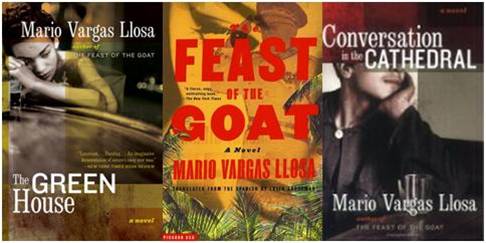Vargas Llosa speaks about Barack Obama’s Nobel Prize, the state of literature, inter-American relations and politics.
With a panel of preeminent scholars and the great Peruvian writer Mario Vargas Llosa, the Americas Society concluded a CUNY symposium entitled Inca Garcilaso de la Vega and his Royal Commentaries: A Reading for the 21 Century in their elegant Park Avenue headquarters.
New York, N.Y. Four hundred years ago an Inca princess borethe son of a Spanish Conquistador. Theirchild, Inca Garcilaso de la Vega, grew up to write the first Spanish-Americanmasterpiece, The RoyalCommentaries (Comentarios reales).
“Comentarios reales” tell the incredible story of the Inca world turned
upside down.
The Royal Commentaries, published inLisbon in 1609 before the Pilgrims landed at Plymouth, tell the incrediblestory of the Inca world destroyed as the Spanish concluded their bloodyconquest of Peru.
There was a backlash to the excesses of
Iberian power. According to The Royal
Commentaries:
The mestizos,the sons of the conquerors of the empire by the Indian women, were… accused ofhaving conspired with Prince Túpac Amaru and theother Incas to rise in revolt…
All those ofCuzco of 20 years or more and capable or bearing arms were arrested. Somewere condemned to torture.
As the Spanish prepared to execute the
prince in Cuzco, leader of the Inca nation, 300,000 people watched.
The majority of the population there was
indigenous, vastly outnumbering the Spanish colonizers, and they were very
angry.
The Inca raisedhis right arm with his hand open, then brought it to his ear, and dropped itgradually to his thigh.
From this, theIndians understood that they were being told to be silent and the shouting andcrying ceased, as they became so quiet that it seemed as if there was not aliving soul in the whole city, to the great astonishment of the Spaniards…
In controlling his own people, Túpac showedthat he was the legitimate and moral ruler of Peru. However, power oftentrumps morality, and the civilization based in Cusco was over.
As a boy, Mario Vargas Llosa told the standing
room-only crowd in Spanish, he read The Commentaries but felt
little. At the university, however, he got it. He felt connected to
the epic book.
“I read it and re-read it. I wasamazed at the incredible antidotes of ancient times. I could taste the colors of the words,” hesaid in Spanish.
Mario pointed out how the language used in TheCommentaries was a “revolutionary act,” as it combined the softness ofQuechua – the Inca language – with the European’s Spanish, creating a hybridthat changed not only Peru but the world.
“Underneath this new language hybrid was afeeling of richness and melancholy,” the author explained. This newSpanish captured the mestizo’s world and became used universally.
ADVERTISEMENT
As an adult, he can now see that the bookexpressed an ideology of a Latin American identity, of a nationalism not tryingto subjugate others, but to unify them.
The evening was launched by a welcome by SusanL. Segal, president and C.E.O. of the Americas Society. Susan came to the Society as a Partner andthe Latin American Group Head at JPMorgan Partners/Chase Capital Partners.
The distinguished session, chaired by AlfredMac Adam, explained Comentarios reales from their respective academicperspectives.
Dr. Juan Ossio ofthe Pontificia Universidad Católica del Peru explained the Inca myths of humanorigins described in the book.
Dr. MargaritaZamora of the University of Wisconsin in Madison spoke of the book’s portrayalof colonialization.
Dr. Thomas Wardof Loyola University in Maryland discussed modern nativist readings ofGarcilaso in Peru.
The symposium co-organizer is DanielShapiro, Director of the Literature Department at the Americas Society.
ADVERTISEMENT
An hour long interview in Spanish betweenMario Vargas Llosa and Dr. Raquel Chang-Rodríguez followed. Raquel, who organized the event, isDistinguished Professor at the City College-Graduate Center of CUNY.
The event wasco-organized by Daniel Shapiro, Director of Literature at the Americas Society.
A book
collecting the symposium’s papers will be edited by Dr. Raquel Chang-Rodríguez.
Mario Vargas is one of the world literature’s most important novelists.
Some critics consider him to have had a larger international impact and
worldwide audience than any other writer of the Latin American Boom. A thought leader in literature and literary
criticism.
A global citizen, he holds a Spanish
passport and lives between Lima and London.

Like many Latin American authors, VargasLlosa has been politically active throughout his career. Like most LatinAmerican intellectuals, he supported Castro in the early 1960s, but graduallybecame disenchanted.
Vargas Llosa ran for the Peruvianpresidency in 1990 with the center-right Frente Democrático coalition,advocating neoliberal reforms. He has subsequently supported moderate conservativecandidates.
Dignified, intelligent, intellectual, withgray hair and gray tie, Mario reminded me of Walter Cronkite, circa 1975. He appeared trustworthy, sober, thoughtful, compassionate – and humorous.
ADVERTISEMENT
Associated with the Boom avant-garde literarymovement in Latin America in the 1960s through such masterworks as The GreenHouse, Conversations in the Cathedral, and The Feast of the Goat,he has written numerous other novels. Healso writes essays, plays, and works of literary criticism.
Under theeditorship of Raquel Chang-Rodríguez, a book collecting all papers presented atthe symposium will appear in April by the Fondo Editorial of thePontificia Universidad Católica del Peru.
A special issueof Review: Literature and Arts of the Americasfocusing on the Inca Garcilaso and His Legacy, will be published in Novemberand launched at the Society on November 12, 2009. Reviewis published by Routledge on behalf of the Society. (Info here)
The Americas Society where he spoke is thepremier forum dedicated to education, debate, and dialogue in the Americas. The room sparkled under crystal chandeliers,the well-dressed audience reflected in its gilded mirrors.
The Americas Society where he spoke is the premier forum for the Americas.
In 1965, a group of noted businessmen led by David Rockefeller founded the
Center for Inter-American Relations. As
the Center’s mission was articulated in 1970, “Ignorance of our neighbors is
neither sensible nor safe, neither smart nor neighborly, neither good
economics, nor good manners…”
ADVERTISEMENT
The Center for Inter-American Relations wasabsorbed into the Americas Society in 1985. Since that time, the Americas Society hasplayed a pivotal role in disseminating the cultural achievements of LatinAmerica, the Caribbean, and Canada in the U.S.
Its mission is to increase public awarenessand appreciation of the diverse cultural heritage of the Americas, as well asthe importance of the inter-American relationship.
Mario Vargas, one of the world’s most important novelists, explains a
finer point to me.
I asked Vargas Llosa what he thought of Barack Obama winning the Nobel PeacePrize. He admitted he was as surprisedas anyone, and believed that the prize was awarded for what the world hopeswill be, not what is.
I believe that Vargas Llosa fans around theworld will not be surprised the morning he is awarded the Nobel Prize forLiterature.
Inca Garcilaso de la Vega’s Coat of Arms.
Note: Any inaccuracies in this piece stemfrom my own inadequacies with the Spanish language. Although I lived in Bogotá for a semester incollege and have visited Lima on occasion, Spanish remains my sixth language. My appreciationto Doris Cramer, Dania Junco, and John Lee.
Follow Jim Luce on Facebook, Instagram, LinkedIn, TikTok, and X (Twitter).
© 2024 The Stewardship Report on Connecting Goodness – Towards Global Citizenship is published by The James Jay Dudley Luce Foundation Supporting & Educating Young Global Leaders is affiliated with Orphans International Worldwide, Raising Global Citizens. If supporting youth is important to you, subscribe to J. Luce Foundation updates here.
